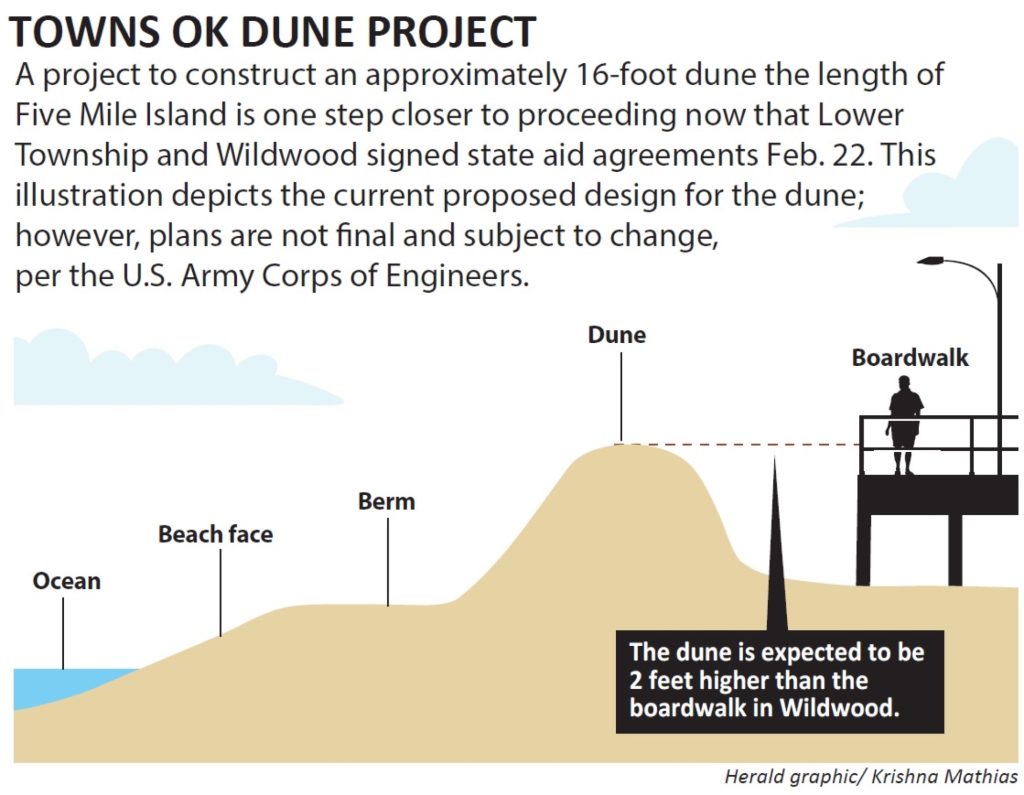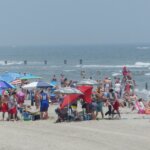WILDWOOD – A shore protection project for the Five Mile Island of the Wildwoods, which has been in the works for 10 years, came one step closer to construction when Wildwood and Lower Township joined North Wildwood and Wildwood Crest in signing state aid agreements that authorized the work on their public beaches.
The project is being sponsored by the U.S. Army Corps of Engineers Philadelphia District and the state Department of Environmental Protection (DEP).
“North Wildwood is experiencing significant erosion of its berm and dune. What was the largest beach in the state now suffers from tidal flooding and wave run-up over a formerly protective beach,” an Army Corps description of the project states. “North Wildwood has lost approximately 1,000 feet of beach during the past five to 10 years. In contrast to North Wildwood, sand accretion in Wildwood and Wildwood Crest is causing extensive maintenance problems and health hazards with their stormwater management system.”
Unlike most of the beach replenishment endeavors the Army Corps and DEP have undertaken, which use an offshore borrow area to dredge sand, which is then pumped onto the beach, plans for the Hereford Inlet to Cape May Inlet project call for the removal of sand from the wide beaches of Wildwood and Wildwood Crest, which would then be hydraulically pumped up to North Wildwood to create a dune and berm and replenish the beach, as well as to the back of the beaches of Wildwood, the Crest and the Diamond Beach section of Lower Township, to create the dune and berm in those communities. The engineered dune would tie into existing dunes toward the south end of the island.
The Army Corps laid out its strategy for shortening the beach in Wildwood and it’s Five Mile neighbors to the south, where accumulation of sand has led to flooding problems and health concerns.
“The excess sand clogs stormwater outfalls, creates pools of stagnant water, produces unhealthy beach conditions and causes associated interior flooding,” the project description states. “During combined periods of heavy rain and high waves, the city cannot access the outfalls for excavation and rainwater becomes trapped within the pipes. The subsequent high-volume discharge of impounded stormwater can also cause spikes in poor water quality.”
Design plans for the project are 65% complete, according to the description, and the project will run a total of about 25,000 linear feet, with the berm taking various widths. The crest of the dune will be 16 feet North American Vertical Datum of 1988 (NAVD 88), according to plans.
For reference, the Wildwood Boardwalk has an elevation of 14-14.5 feet NAVD 88, according to city engineer Anthony Chadwell, and the top of North Wildwood’s bulkheads are at about 12 feet NAVD 88, according to Jim Verna, an engineer for that city.
Verna cautioned that the dune crest may not be just 4-feet higher than the existing bulkhead for long, though.
“That is factual at the time of construction, but over time, it will grow with the vegetation (dune grass) and sand fencing capturing sand. It will not take long for the dune crest to be above elevation 16’,” Verna wrote to the Herald.
Verna said the goal is to cover the existing bulkhead with the dune wherever possible.
“The exception will be at 5th Avenue where the bulkhead will be realigned,” he added.
In Wildwood, it is still unclear how the dune would tie into the boardwalk and how much space, if any, would be between them. Currently, stairs take you off the boardwalk and down to the beach. Chadwell said because the design phase is not complete, he couldn’t say how beach access would work when the dune is finished.
Estimates for the total cost of the project, which were made in March 2014, call for a $104 million total cost. That includes 12 renourishments slated every four years, in addition to the $21.6 million initial phase, which includes real estate acquisitions and construction of the dune. Given inflation and other economic complications, those numbers will now likely be much higher.
The initial phase of the project’s cost is covered 65% by the federal government and 35% by non-federal sponsors, like the state DEP. Renourishments will be split 50-50.
Now that the towns have signed off, there is still work to be done before the project can break ground. Privately owned beaches in Wildwood and Lower Township that interfere with the project site need to be acquired by the state.
“Construction cannot move forward until the real estate is in place,” the Army Corps description states.
Now, the state will work to acquire the necessary easements from private property owners to complete the project. It is unclear how long that may take or how difficult it may prove to be negotiating with those private beach owners.
Thoughts? Questions? Contact the author, Shay Roddy, at sroddy@cmcherald.com or 609-886-8600, ext. 142.







